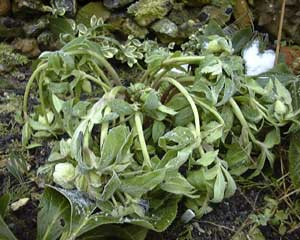

Seed Sowing.
Hellebores can easily be raised from seed; in many gardens clusters of seedlings appear around the base of mature specimens during winter. When choosing seed to collect and sow, a quality plant - strong, healthy, with good flower shape and colour - is most likely to produce the best offspring. If one colour is grown in isolation the results will be more predictable, but nothing is definite, there is always an element of surprise. And it is worth remembering that many different colours, all grown together, will produce highly unpredictable results. Unfortunately, this is just as likely to mean dirty colours as something new and exciting.

To achieve success with germination the most important factor is to obtain fresh seed. Ideally it should be sown as soon as it ripens, or stored for just a few weeks in a paper bag. Shop bought seed, often many months old, is a frequent source of disappointment. Small quantities of seed can be sown individually, but I prefer to use 10cm pots filled with compost to within 1cm of the rim. I then sow thinly with seed and cover with fine horticultural grit. The finished pots are placed outside in a shady position and covered with wire netting to prevent birds from scratching out the contents. Germination takes place in winter, often after the first heavy frosts. I then move the pots to a coldframe, partly to avoid problems with marauding slugs and snails, but more than anything to protect them from mice - a major problem as they are very keen on eating both seeds and emerging seedlings. If these hazards can be avoided there is no reason why pots cannot be left outside, although some shelter is preferable in very severe weather. Greenhouses need to be kept well ventilated as stuffy conditions can cause fungal diseases.
Potting on.
Once the plants have developed their first true leaf they can be potted on. To do this gently tip up the pot, supporting the compost with your fingers while avoiding contact with the plants. The soil can then be loosened and each plant separated ensuring that you handle only the leaf. Never touch the stems as they are extremely fragile and easily damaged. In autumn the plants will need larger pots or alternatively they can be planted out in their final positions. The first flowers appear two years after germination which means a total wait from pollination of a rather lengthy three years. A small percentage of plants flower a year early or during the following summer, but most out of season flowers will not come true, being badly shaped and coloured. This is not, of course, permanent; improved flowers will appear the following spring.

Growing conditions.
In the wild the ancestors of these hybrids can be found growing in a wide range of situations from open grass to woodland. Gardeners in the UK often associate them with the latter, but this can be a little misleading when it comes to planting. The ground under very mature trees, assuming there is enough light, will likely require the addition of quantities of organic matter to build up the topsoil, if plants are to flourish and not just survive. Even then the area directly surrounding the trunk will remain an inhospitable place more suited to plants such as hardy cyclamen that have a summer dormancy. A position near the canopy edge, or around smaller less greedy ornamental trees and shrubs, should prove ideal. The aim is to provide light shade and moist but not waterlogged soil. Many gardeners have to rely on shade provided by fences or walls and this should be perfectly adequate, but the ground immediately at the base of house walls should be avoided as this area receives little moisture. A position in full sun is not necessarily unsuitable; in my garden I have hellebores flourishing in hot sunny conditions, but the soil is a good loam over clay that rarely dries out. Lack of water would be more of a problem on dry/thin soil. Putting all this aside, the tough leathery leaves of hellebores make them resilient and adaptable plants that stand a good chance of growing well in most situations and soil types. They develop a strong root system that extends well down into the soil and the addition of humus (leaf mould, rotted garden compost, peat substitute or, on acid soil, spent mushroom compost), dug deeply in before planting, will be beneficial. Grit will help to improve the chances of success on poorly drained soil, but a very wet position is unlikely to prove suitable.
Most growth takes place in spring and autumn with a rest period in summer. Tatty leaves should be removed in late autumn, while any clean disease free ones can be retained until flowering when they will need to be thinned or removed to allow the new buds space to develop. In any case, all old leaves should be removed before the new ones form. New leaves are produced immediately after flowering. Usually I have a few plants in bloom as early as November, but the majority start from January onwards. At such times they are forced to cope with the worst of weather conditions; after a hard frost the flower stems will bend over, often to the extent that their heads touch the ground.

Even after remaining in this state for several days most plants will make a complete recovery when temperatures rise. I rarely notice any permanent damage, but early growth is more likely to be hit, and abnormally mild conditions in autumn can confuse hellebores in to thinking that it is time to grow. Hellebores do not like global warming!